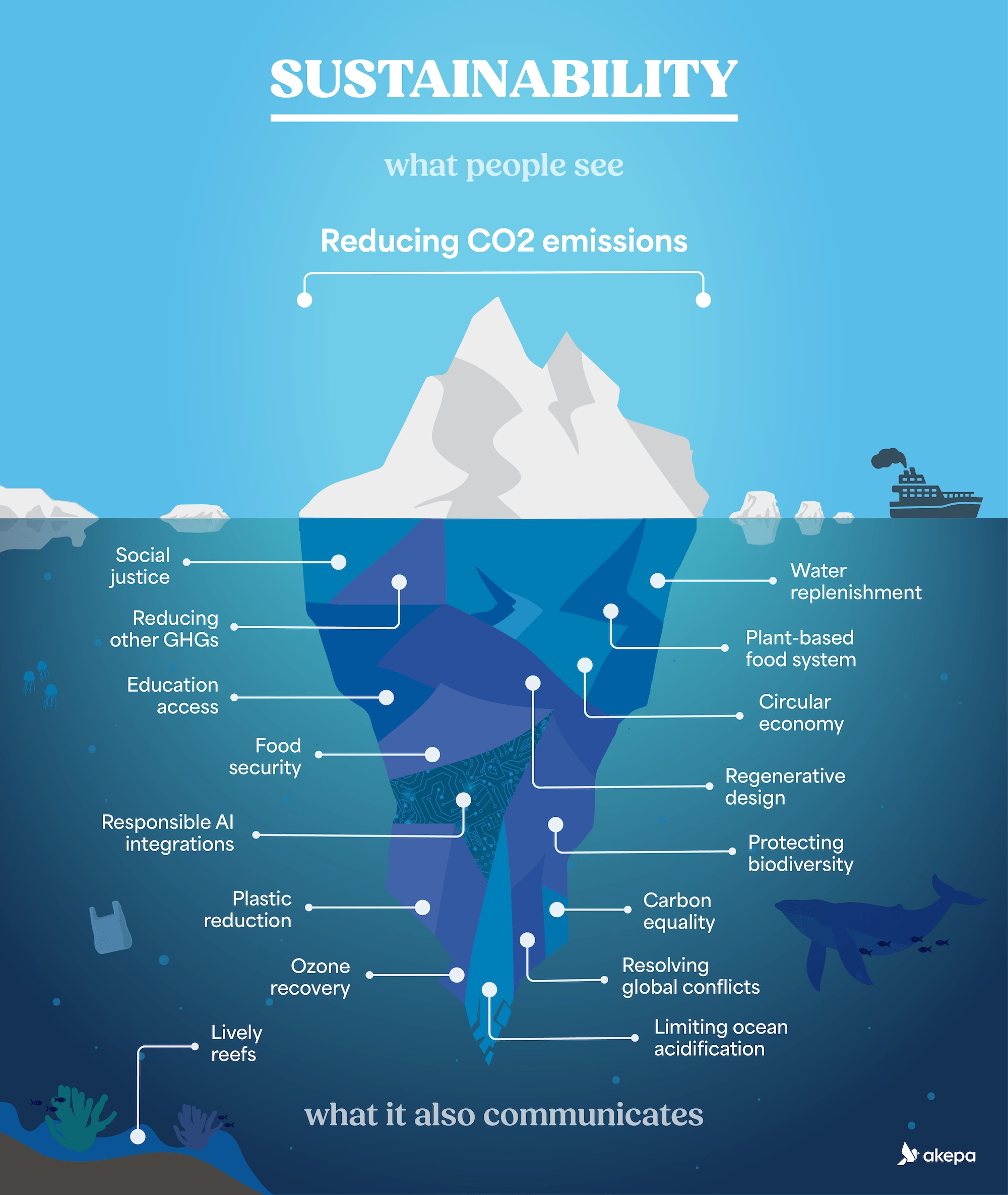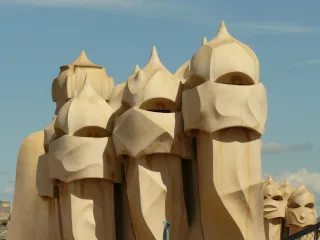We’ve written about what sustainability means before on this blog. But that doesn’t stop us from trying to find new ways to grasp it.
With the obvious side that everyone sees on CO2 emissions but also a vast amount under the surface – what better way to visualise than an iceberg infographic? When you consider the link between sustainability and climate change, there’s literally no better way to put a scene to the term’s depths.
Here are just a few of the issues that sustainability can communicate, as well as the conspicuous reduction in CO2 emissions that many of us see.
Note that this post is an adaptation of some content originally created for Linkedin – and recycled for our blog. It’s part of a new habit of content recycling that’s getting a bit moreish.

Now let’s look at each of those areas in a little more detail and why sustainability includes them…
Remember, these issues aren’t isolated and are rather intersectional. Take the level of CO2 in our atmosphere, which is linked to biodiversity loss. In turn, biodiversity is threatened by plastic pollution – and so on!
Social justice
Sustainability is about planet but it’s also about people – we shouldn’t forget that. Social justice is a term that encompasses the moves to make our society more equitable and just. It’s about the fair balance of opportunities, privileges, and wealth.
Reducing other GHGs
CO2 isn’t the only GHG involved in global warming and it’s definitely not the most powerful. Methane, for example, is responsible for around a third of global heating and is said to have around 80 times the warming power of CO2. Thankfully, it has a shorter lifespan in our atmosphere.
Education access
As we’ve said, sustainability is about people and the more people have access to education then the better chance we have of a sustainable future. One way to think about sustainability is also to consider the United Nations 17 Sustainable Development Goals (SDGS) – and this is number 4, by the way.
Food security
We’ve become disconnected from how our food is produced and where it comes from. As a result of this, and the added climate change effects, 45% of the population suffers from food insecurity. We need a shift where food isn’t just a commodity we have but where food is a right that we have control over.
Responsible AI integrations
We’re living through an AI revolution but there are risks ahead, as well as opportunities. AI could be a kind of genius that helps us crack the climate crisis – but there are issues like brain drain, job losses, and the vast emissions of data centres to contend with, too. Integrating AI into our lives responsibly is a must, if we seek a sustainable future.
Plastic reduction
There could be more plastic in our oceans than fish by 2050 – according to Ellen Macarthur. That’s absolutely disgusting. A more sustainable future is going to have to involve far less plastic. It gets everywhere and causes all sorts of problems. Not just the ugly big bits either, but also the menacing little microplastics.
Ozone recovery
By eliminating ozone-depleting chemicals and CFCs, the ozone is in a healthier state than it once was. Yet, there’s still a hole there and it’s sometimes the largest on record. Another way to consider sustainability is also the 9 Planetary Boundaries, of which ‘Stratospheric Ozone Depletion’ is one.
Water replenishment
Water scarcity is becoming more prevalent globally with climate change. Droughts are increasing in many parts of the world. But water is an important factor in mitigating climate change – and keeping societies sustainable. Not just human societies but also those of precious creatures (e.g. flamingos).
Circular economy
Our steps to a more sustainable future must involve less new stuff. Unfortunately we’re in the bad habit of throwing away and buying again and again, when we could be redesigning, recycling, reusing and repairing. That way, the product lifecycle elongates, rings around, creating less waste and emissions.
Regenerative design
The term ‘regenerative’ has become popular in recent years. Regenerative sustainability aims higher than typical sustainability, as it is supposed to result in net positive impact vs minimising harm. It is a nature-based design philosophy that takes into account a world of finite resources.
Protecting biodiversity
Biodiversity loss is inexorably linked to global warming. As the planet heats up, the diversity of flora, fauna and funga on our planet is in drastic decline. The issue has been rare itself but is reaching popular awareness now. There are even biodiversity stripes to match the famous climate warming stripes.
Carbon equality
The wealthiest 1% of people are responsible for as many carbon emissions as the poorest 66%. Yet, it’s the latter that suffer the most from climate change. In other words, those who pollute less face more losses: air pollution, food insecurity, flooding, hurricanes, poverty, etc. More balance and reparations are in order.
Resolving global conflicts
How can we talk about sustainability, sincerely, while the world is at war? This is an interconnected world. How can waffle about lower emissions or social justice, while the conflicts we support cause environmental and humanitarian disasters? Resolving the world’s wars and conflicts isn’t straightforward, to say the least, but it has to be acknowledged alongside sustainability pledges and chat.
Limiting ocean acidification
When CO2 is absorbed by the ocean, it causes the PH to drop – to acidify. This harms the life within, which in turn depletes our oceans’ ability to absorb GHGs. Like biodiversity, this is another (scary) story that can be understood with Stripes. Take a look at the ocean acidification stripes.
Lively reefs
When we think about CO2 and biodiversity the natural trip to take is above the water, especially to rainforests. However, the majority of CO2 is actually absorbed by our oceans – and reefs are home to around 25% of all marine life. These otherworldly habitats are key to carbon sequestration and food security.
Even this is just the tip of the sustainability iceberg:
And, when you think about it, it’s ironic – and perhaps a weakness of the infographic if we were being picky – that even this is just the tip of the iceberg. There’s so much more we could include.
Let us know if we’ve missed anything massively important that should be here – and if you’d like to get in touch with Akepa or work with us, you can do so at the form below.



Leave a Reply